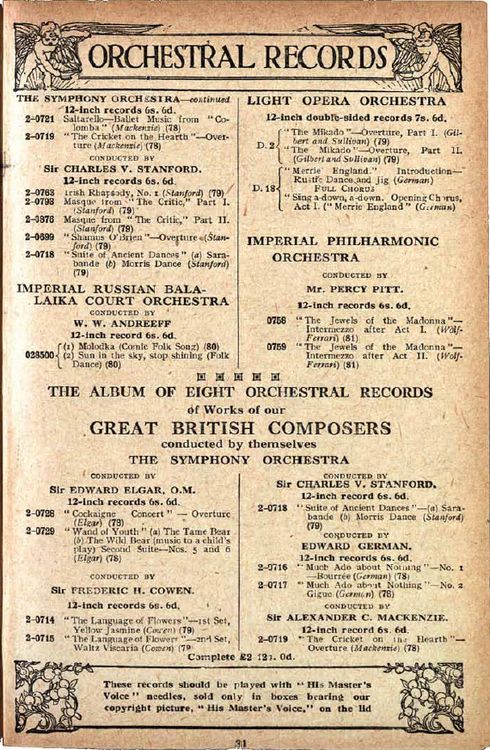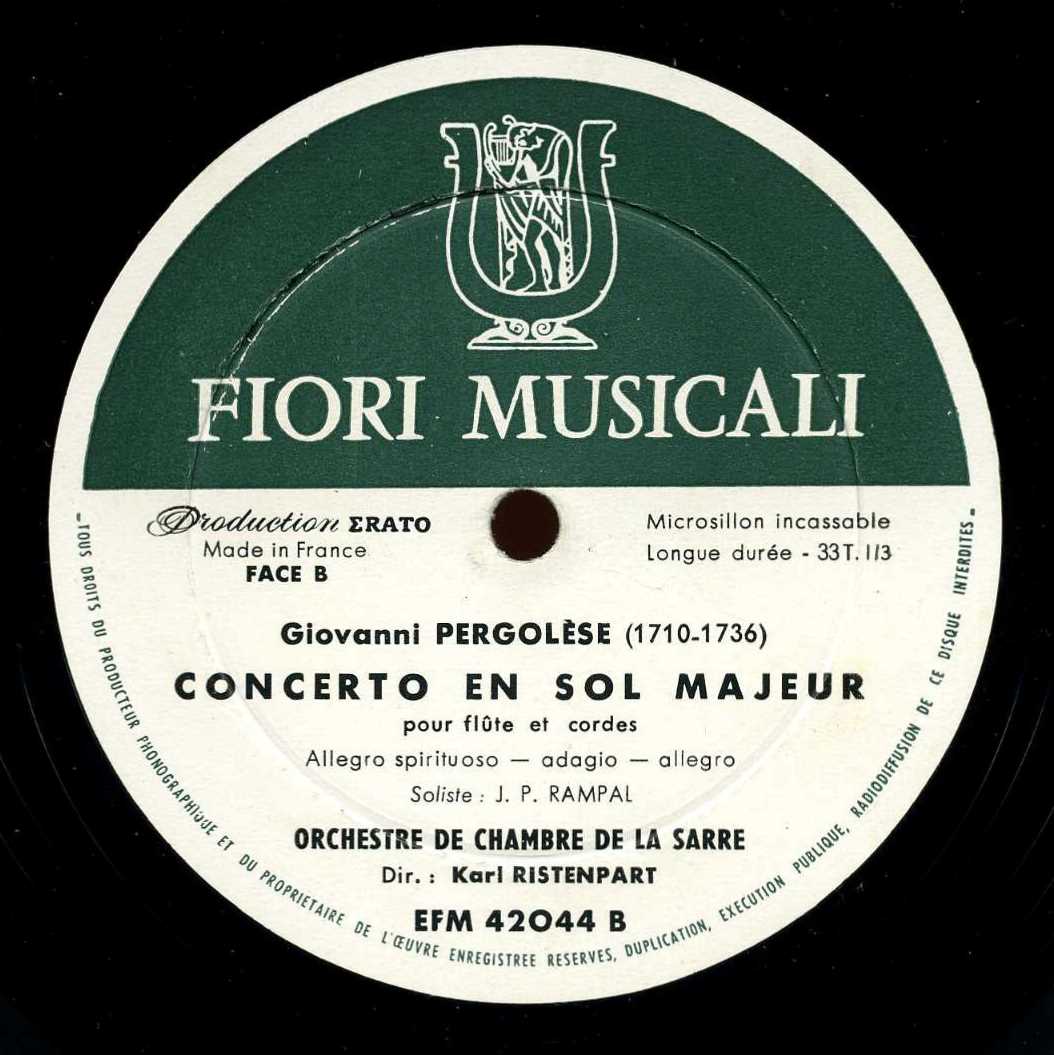Orchestral
Recordings are in FLAC format downloadable through MediaFire by clicking on each title.
Quick links to the downloads - more info on each track below.
Herr
Meny's White Viennese Band:
Ivan Caryll: - The Earl and the Girl Waltz
Sir Henry Wood: New Queen's Hall Orchestra
Rossini: Semiramide Overture
Sir Henry Wood: New Queen's Hall Orchestra
Wagner:
Tannhauser Act I Venusberg Music
Ethel
Smyth, The Symphony Orchestra
The Boatswain's Mate - Overture
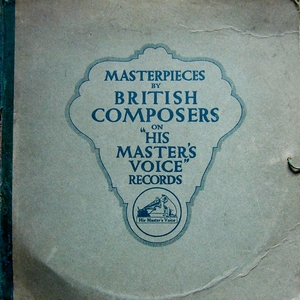
This HMV album was probably marketed towards the middle of 1917 in all likelihood as a propaganda gesture
with the music on the records appears to have been chosen to instill patriotic feelings in the breast of every true Briton. The oldest composition was some 37 years old and the newest only three years old, so the album reflected modern music by established composers, but nothing too serious or heavy.Although Elgar had already begun recording by 1914, Cowan, German , Mackenzie, and Stanford were all new to the recording horn, with only Elgar and German continuing to make recordings after the Great War. I have included a page from the HMV 1919
catalogue [see below] which advertised the records at £2 12s with the album gratis. The collection appears to have been dropped by 1920 or 1921 and thus never formed part of the numeric album series. I have also included extracts from Alan Kelly's Discography of the 12" HO series which gives details of each recording session.Elgar's Cockaigne has been well and truly truncated the label has using the appellation 'Concert' to convey the cuts; Mackenzie's The Cricket on the Hearth Overture is likewise fairly chopped down however the other compositions are complete or fairly so. The odd sound you hear in the Mackenzie piece is the Cricket rubbing its legs! Although all the labels say 'Symphony Orchestra' the recording sheets have Cowen and Mackenzie conducting the Royal Albert Hall Orchestra. I have bundled all the recordings into one file of formidable size [see foot of this page].
Links to Wikipedia entries on Frederick Hymen Cowen, Edward Elgar, Edward German, Alexander Campbell Mackenzie and Chales Villiers Stanford
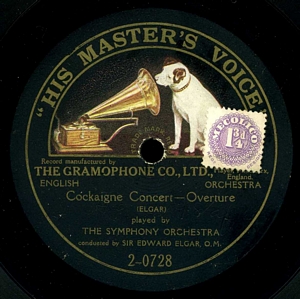
Elgar: Cockaigne Concert - Overture [Op. 40, 1900]
[file
size 24MB]
Recorded: 27 February 1917, Matrix: HO 2498 af Cat.
No. 2-0728
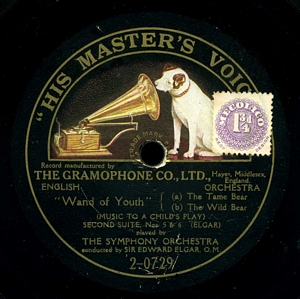
Elgar: Wand of Youth [Second Suite]
(a) The Tame Bear (b)
The Wild Bear [Op. 1b, 1907-08] [file
size 21MB]
Recorded: 27 February 1917, Matrix: HO 2502
af Cat. No. 2-0729

Cowen: The Language of the Flowers 1st Set: Gavotte - Yellow Jasmine [1880]
[file
size 22MB]
Recorded: 4 December 1916, Matrix: HO 2369 af
Cat. No.2-0714
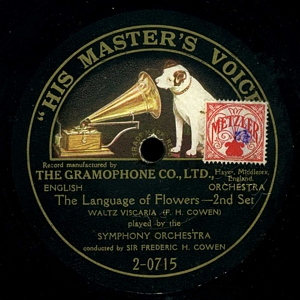
Cowen: The Language of the Flowers 2nd Set: Waltz - Viscaria [1914]
[file
size 22MB]
Recorded: 4 December 1916, Matrix: HO 2368 af Cat.
No.2-0715

Recorded: 5 November 1916, Matrix: HO 2297 af Cat. No.2-0718
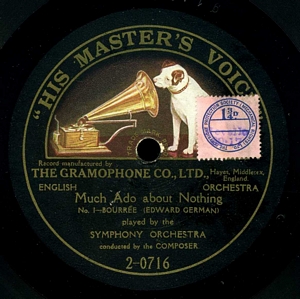
German: Much Ado about Nothing No. 1 Bourrée [1898] [file
size 24MB]
Recorded: 14 July 1916, Matrix: HO 1997 af
Cat. No.2-0716
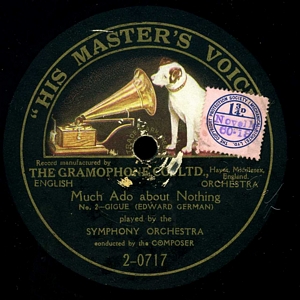
German: Much Ado about Nothing No. 2 Gigue [1898] [file
size 12MB]
Recorded: 1 December 1916, Matrix: HO 2350 af Cat. No.
2-0717
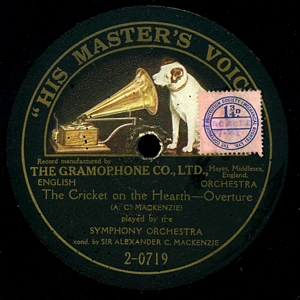
Mackenzie: The Cricket on the Hearth Overture [Op 62, 1901] [file
size 20MB]
Recorded: 17 September 1916 Matrix: HO 2173 af Cat. No.
2-0719
Page from HMV Catalogue of Records September 1919
All the tracks of Masterpieces of British Music bundled together in one RAR file [File size 170MB]
Jean-Pierre RAMPAL
Orchestre de Chambre de la Sarre
Karl Risenpart conductor
Pergolese: Concerto in D Major for Flute and Orchestra
[file size 27MB]
Pergolese: Concerto in
G Major for Flute and Orchestra
[file size 30MB]
Recorded: 1958 or before
Matrix: EFM 42044-A-
& EFM 42044-B-3
Cat. No. ERATO: EFM 42044
Format: 25cm
(10inch); double-sided green & white label
Of the enormous number of recordings made by J.-P.Rampal I do not think this LP has ever been reissued although one side may have found its way onto a compellation in the late 1960s but I am not exactly sure of this.
It seems doubtful if these works are actually by Pergolese but they are certainly by somebody of his time.
Sir Henry Wood and New Queen's Hall Orchestra
Wagner:
Tannhauser Act I Venusberg Music
[File size 41 MB]
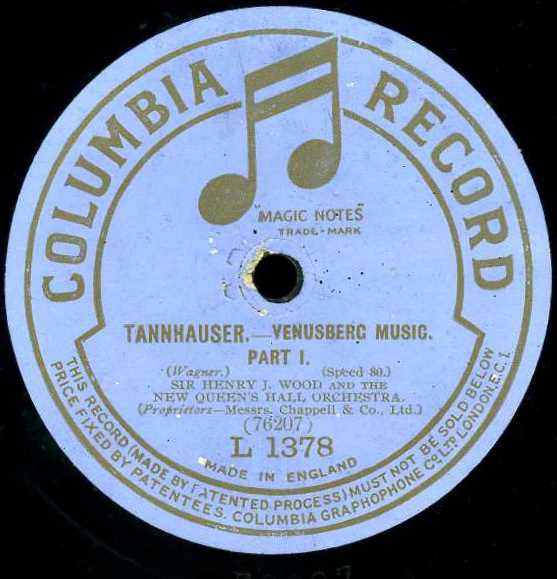
Recorded: 22nd November 1921.
Matrix:
76207-4 & 76206-5
Cat. No. Columbia L 1378
Format: 30cm
(12inch); double sided blue label
This is the second issue of the of L 1378, the first issue of 1918 of 'Henry Wood and His Orchestra' contained the, matrixes 76207-2 & 76206-4, and was available from September 1920 to June 1922, the present disc was deleted in February 1928 probably in favor of the recently issued overture and Venusberg music by Willem Mengelberg and the Concertgebouw Orchestra on L 1770-1771.
A better site for Henry Wood recording is Damian's 78s who has uploaded a very good selection from his recorded output.
Adrian Boult, conducting The British Symphony Orchestra
Scarlatti
arr. by Tommasini: Le donne di buon umore [The Good-humoured Ladies]
[File size 40.9 MB]
Recorded: 5th & 16th November 1920 & 21st July 1921.
Matrix:
HO 4598-2af; HO 4617-2af; Cc 382-2 & HO 4598-2af
Cat. No. HMV D521 & D573
Format: 30cm
(12inch); double sided, black label
Speed: 82; 81; 78 & 77.5rpm
[unfortunately I do not have the score to hand but have believe the work
begins and ends in G so have pitched it accordingly]
Not exactly the first piece of music to come to mind in association with Sir Adrian Boult even the recording of this piece was all a bit speculative or opportunistic one feels.
Boult was employed to replace from Ernest Ansermet as one of the conductors of the Diaghilev Russian Ballet at the Empire Theatre, London from October to December 1919 One of the ballet's Boult conducted for Diaghilev was Vincenzo Tommasini arrangement of Scarlatti sonatas into the ballet The Good-Humoured Ladies [Le donne de buon umore]. Tommasini arranged the music into a Suite in 1920 and it is this arraignment that I think Boult recorded but I am a bit unsure on this point. I can find only one instance, although there will have been others, of the Suite being performed by Boult with The British Symphony Orchestra on the 30th October 1921 which was reviewed by The Times the following day.
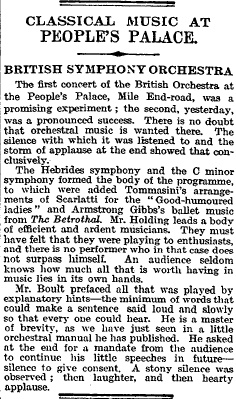
Boult was signed up by Fred Gaisberg of HMV at the end of 1920, the conductor recalled that 'We trekked down to Hayes one morning, and found ourselves in a studio so small that it would hardly have held a full-size billiard table besides the essential chairs and music stands and an enormous gramophone horn … Immediately in front of this sat the leader of the orchestra with his fiddle as near inside the mouth of the horn as he could hold it. He was surrounded by a few strings, but in those days, apparently, the low tones of the double-bass were an impossible proposition and the double bass part was in the hands of a gentleman with a tuba who puffed away in the furthest corner of the studio with remarkable results. I always longed to hear him operating the arpeggios in the last movement of Beethoven's No. 5 …' quoted by Michael Kennedy in Adrian Boult, Hamish Hamilton, London 1987 p. 77.
The British Symphony Orchestra was given a short notice in Musical Times for 1st October 1919.
'This organization made a very auspicious first appearance at the Royal Albert Hall on September 2I. The words ' first appearance,' however, read oddly in connection with a band largely made up of players whose names are well known to London audiences, some of them as soloists. The ' British Symphony Orchestra' begins by claiming attention on the ground that all its members have served in the Army, mostly abroad, but it should soon take a prominent position on its musical merits. Mr. Raymond Roze conducted, and Mr. Tom Burke sang.'
Among the cellists of the orchestra was ex-Lance Corporal John Barbirolli who may have been one of the 'few strings' mentioned above by Boult. Another series of People's Palace concerts given under Boult's conductorship in the autumn of 1922 but proved to be failure and the orchestra was disbanded soon afterwards.
The recording was cut over three days in four? sessions This is what probably caused the speed differences between sides. Part 3 must have caused some trouble as the orchestra had to reconvene eight months after the first sessions and would accounts for the gap between catalogue numbers with D521 issued in March 1921 and D573 probably in September.
|
Matrix |
Rec. date |
s/s No. |
Part/side |
Cat No. |
|
HO4595-1af |
05/11/20 |
Pt 4 |
||
|
HO4595-2af |
05/11/20 |
3-0643 |
Pt 4 |
D573 AB9 AW4272 |
|
HO4596-1af |
05/11/20 |
Pt 3 |
||
|
HO4596-2af |
05/11/20 |
Pt 3 |
||
|
HO4598-1af |
05/11/20 |
Pt 1 |
||
|
HO4598-2af |
05/11/20 |
3-0563 |
Pt 1 |
D521 AB8 AW4270 |
|
HO4617-1af |
16/11/20 |
Pt 2 |
||
|
HO4617-2af |
16/11/20 |
3-0564 |
Pt 2 |
D521 AB8 AW4270 |
|
Cc 382-1 |
21/07/21 |
Pt 3 |
||
|
Cc 382-2 |
21/07/21 |
3-0642 |
Pt 3 |
D573 AB9 AW4272 |
'Discus' [has anyone pinned down who this was?] writing in Musical Times for 1st March 1921 reviewed the discs.
An exceptionally good batch of H.M.V. records arrives just as this review is being closed. I have space now to mention only three. On a double- sided is Butterworth's 'Shropshire Lad' Rhapsody, played by the British Symphony Orchestra, conducted by Mr. Adrian C. Boult. Some of the pianissimo sections are barely audible, otherwise this is a very successful record. In violent contrast to its wistful strains is the Scarlatti-Tomasini [Tommasini is spelt on the record labels with one 'm'] 'Good-humoured Ladies,' a concert version of the popular ballet music, played by the British Symphony Orchestra under Mr. Boult. This example bears out what was said above as to the excellent results obtained from records of orchestral works in which the scoring makes liberal use of strings and wood- wind. The brass so plentifully used in most modern works rarely makes a good show. The trumpet loses its nobility, and suffers a sea-change into something neither rich nor strange-in fact, it comes down in the world, and joins hands with its humble brother of the toyshop, price one penny (pre-war). The lower brass often becomes no more than a vague snore. In 'The Good-humoured Ladies' the texture of both music and scoring is light, bright, and clear. I have not so far heard an orchestral record in which the scoring could be so easily followed. One could give a lesson in orchestration from such a record as this. Of the music itself, with its old-its old-world gaiety and charm, there is no need to speak.
This review throws up an interesting question, had Discus all four parts/sides or just the sides 1 & 2, if the latter he must have been provided with an unissued take of side three although this would be highly unlikely. Other interesting snippets of information are that John Barbirolli may be one of the cellists in the recording and that the records were deleted in 1926 with the cull of great swathes of acoustic recordings.
Herr Meny's White Viennese Band
Ivan
Caryll: The Earl and the Girl Waltz
[File size 11.7 MB]
Recorded: September 1906.
Matrix:
762c
Cat. No. Gramophone Monarch Record, 082
Format: 30cm
(12inch); single sided black label
Speed: 79.5 rpm
The reason I have included this recording is due to the fairly often quoted account of Holst playing in a 'White Viennese Band'
'To earn a living in the period before he had a satisfactory income from his compositions, [Holst] played the trombone the Carl Rosa Opera Company and in a popular orchestra called the White Viennese Band, conducted by Stanislas Wurm. The music was cheap and repetitive and not to Holst's liking, and he referred to this kind of work as "worming" and regarded it as "criminal". His need to "worm" came to an end as his compositions became more successful, and his income was given stability by his teaching posts.' from Wikipedia Holst article.
Maybe someone out on the web was wondering what these sounded like as they drifted through air of the Edwardian seaside.
Sadly I do not know of any recordings made by Wurm's White Viennese Band but I do have a recording of Herr Meny's White Viennese Band which I believe was a rival concern led Philippe. R Meny, a composer of light music. The name refers to the white uniforms they wore made in imitation of Austro-Hungarian military uniforms of the time. Indeed Ibbs & Tibbett the concert impresarios had on their books White Viennese, Red Viennese, and Blue Hungarian Bands. These bands were a feature of seaside resorts and spars before the First World War and could be hired out for private functions and garden parties. Clearly there was some amount of competition and Wurm was in court in 1897 and again in 1904 defending the name of his band. Those of you really very keen to read more of this can download these pages from The Times in pdf format giving detail accounts of the trials - [1897 court case] [1904 court case] [File size 1mb each].
The band to our ears is very like any military band of the period although I dare say they affected an 'Austrian' feel even though most of the musicians were probably British.
The Earl and the Girl was a hugely successful musical comedy that opened in London in 1904 and in New York the following year. Meny's arrangement would still be popular when recorded, but unlike some other selections the record was deleted and never doubled onto the HMV C label. Two of the other selections recorded by the band however lasted until the General Catalogue of 1922.
The records may have been made not only for home listening but also for the developing market of canned music for fete's and other small open air events that could or would not run to the expense of live musicians, these records are quite loud if played on a acoustic machine. The likely reason for the Gramophone & Typewriter Co. to record a batch of recordings in September 1906 could be connected with the highly successful Imperial Austrian Exhibition being held Earls Court at that time. I do not believe Meny's Band played at any of concerts given at the exhibition but then Fred Gaisberg may have thought it worthwhile thinking it both a topical and profitable venture.
Although of questionable musical importance these recording have rarely been of interest to collectors and are in the greatest danger of being slowly lost altogether. They were the real bread and butter business of record companies and should be preserved so that our understanding of musical history is not skewed. End of soap box rant.
A full list of the what Meny's White Viennese Band recorded from Alan Kelly's monumental work on Gramophone Co. matrix series I have transcribed into a pdf . The Orchestra and accompaniment to Charles Knowles and Messiah overture look suspiciously as if Meny's band was also pressed into doing some Handel while they were in the studio! Meny's Discography
Sir Henry Wood and New Queen's Hall Orchestra
Rossini:
Semiramide Overture
[File size 19.5 MB]
Recorded: July 1919 issued January 1921. [Thanks to Damian's
78s for this info]
Matrix:
76543 & 76545
Cat. No. Columbia L 1395
Format: 30cm
(12inch); double sided blue label
Speed: 81.8 & 81.25rpm
For Henry Wood you should really go to Damian's 78s who has uploaded a very good selection from his recorded output.
Although famous in his time Wood has been generally quite neglected on CD modern reissues. Admittedly his conducting style is sometimes criticized as a bit rough and ready but then he was more intent on giving the public an incredible variety of music. Wood's tally of first performances and UK premières being stated to be at least 717 works by 357 composers. His recorded legacy gives a good idea of the musical standards accepted by the general public in the first quarter of the twentieth century and although the Semiramide is truncated it shows Wood and the New Queen's Hall Orchestra giving the piece some gusto.
Bruno Seidler-Winkler: Großes Symphony Orchester (Members of the State Opera Orchestra, Berlin
Adolf Screiner (1847-1921) Fantasie über Motive aus G. Bizets Oper
'Carmen'[File size 24.1 MB]
Recorded: 1929?
Matrix: 1580 & 1581 [TE13 &
TE6]
Cat. No. Tri-Ergon, Photo-Electro-Record
Format: 30cm
(12inch); double sided red & black label
Speed: 78 rpm
The Tri-Ergon system used film as the medium for recording. The quality was quite high considering the technology however you can hear from time to time sounds reminiscent of birds twittering [at 0.49]together with some problems in the lower frequencies [at 4.32]. The 78 recording would have been transferred from the film and it may be during this process that this distortion crept in. At the end of the track before my fade out you can hear the fade out of the film when the disc engineer turned down the input.
Seidler-Winkler made the first complete recording of Carmen in 1908 (available through Marston) and a short biography with a good selection of other recordings from the 1930s are available from the Charm site. Like the Meny's White Austrian Band recording above, this disc of Adolf Schreiner's Fantasy on Bizet's Carmen
was probably popular with the public but unlikely to be reissued commercially; the music and composer have almost sunk without trace.Ethel Smyth, conducting Symphony Orchestra with Gilbert Barton & W. Gordon Walker (piccolos)
The
Boatswain's Mate - Overture
[File size 24.5 MB]
Recorded: 2nd October 1916.
Matrix: HO 2197af &
HO2198af
Cat. No. HMV 2-0696 & 2-0697
Format: 30cm
(12inch); single sided black label
Speed: 79rpm
[unfortunately I do not have the score to hand but have assumed the opening
notes to be in A at 440Hz]
In all eight sides were issued of Ethel Smyth's The Boatswain's Mate including these two sided of the overture, the other six side included songs by members of the cast.
Links to Wikipedia articles on the opera and composer
Review of the original production from The Musical Times,Vol. 57, No. 877 (Mar. 1, 1916), p. 155
Shaftesbury Theatre. 'The Boatswain's Mate.'
Comic Opera, by Dr. Ethel Smyth. The text by the Composer, founded on a story by W. W. Jacobs.
Chief Characters.
Harry Benn (ex-Boatswain) - Courtice Pounds
Ned Travers (ex-Soldier) - Frederick Ranalow
Mrs. Waters (Landlady of 'The Beehive') - Rosina Buckman
Mary Ann (a Servant Girl) - Norah Roy
A Policeman - Arthur Wynn
Two Cats (behind the scenes) - M. Voxo
(First performance on January 28, [1916] conducted by the Composer.)
This is a work about which much had been heard before its production at the Shaftesbury Theatre. It was down for performance at Frankfort, and, but for the war, would have been produced there in March, 1915. Dr. Smyth believes that her music has hitherto been more appreciated in Germany and Austria than it has in this country. As it is, we have to be grateful that events have allowed us to be the first to honour a very clever native composer.
The story is in the true Jacobs vein. 'The Beehive' is a country inn, kept by a smart and attractive widow, Mrs. Waters, to whom Harry Benn, a retired seafaring man, makes awkward advances which are contemptuously repelled. As fair means will not win the lady, Benn tries strategy.He persuades Ned Travers to attempt a burglary on the premises, and arranges that at a given moment, he (Benn) is heroically to rescue the dame, and thus secure her life-long gratitude. But Mrs. Waters turns the tables on Travers by confronting him with a gun and extorting a confession of the plot. She arranges to pretend to shoot him dead, and when Benn appears on the scene to effect the rescue, she informs the terror-stricken scamp what has happened. Benn is miserable at the thought of his guilt and gives himself up to the police, and the play ends with a hint that possibly the widow will change her name to Travers.
The story, with its suggestion of the immense superiority of woman to mere man is one that appeals to Dr. Smyth. There are several sly touches that give vent to her well-known views. The music is bright and generally fits the situations. Folk-songs are drawn upon: 'The Keeper,' 'The cruel mother,' 'O dear, what can the matter be,' 'Lord Rendal' (which is particularly well treated) are amongst those heard. An Intermezzo between the two parts of the Opera uses 'Briars and Bushes' in a solemn, serious way, but it is hard to see what such music has to do with the play. There is a distinctly humorous use made of Beethoven's ' Fate knocking at the door' theme (from the C minor Symphony) when the policeman arrives. For the rest, there are excellent songs for all the chief characters, and some effective concerted music. Sometimes the dialogue is spoken, and sometimes set to a sort of recitative, apparently for no ether reason than to avoid monotony. The composer can write good tunes, and has resources of rhythm to draw upon and ability to orchestrate piquantly. An episode at the end of the first Act is very amusing. Some half-tipsy and still thirsty labourers call at the 'pub' on their way home. Their efforts at music admirably mimic the bank holiday concerted performances with which we are only too familiar. The two cats, which we only hear, are not very funny, and the character of Mary Ann seems redundant. The performance was a particularly good one. Miss Buckman made it easy to understand the passion of Harry Benn. She sang and acted with great charm, and was tantalizingly vivacious. Mr. Courtice Pounds gave us a clever study of his part. Mr. Ranalow showed himself to be a good comedian as well as an effective singer. The opera was mounted well, and the stage-management maintained the reputation of the theatre, which stands high.

